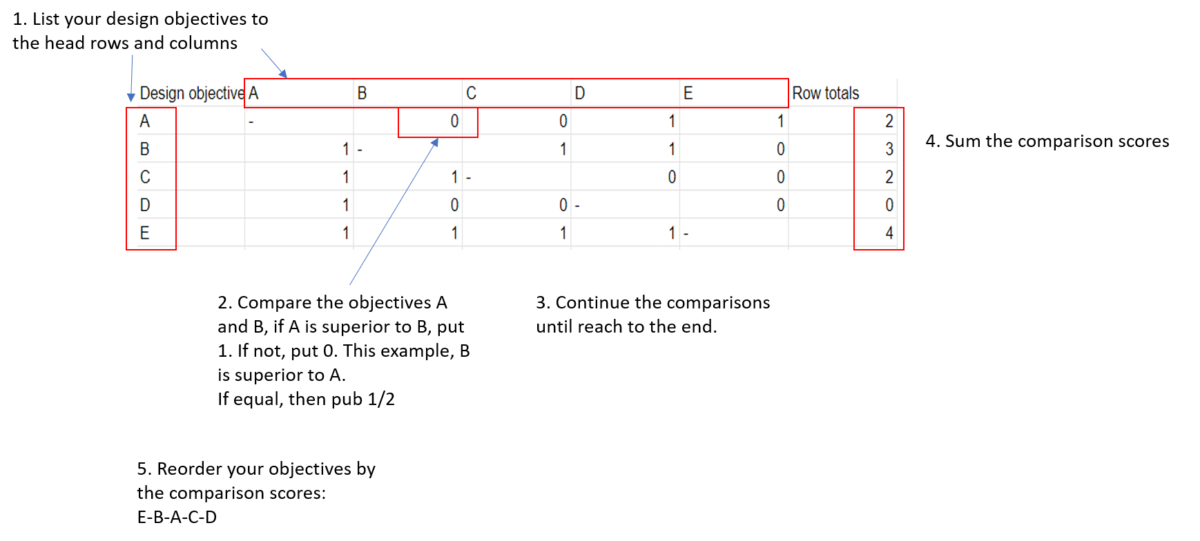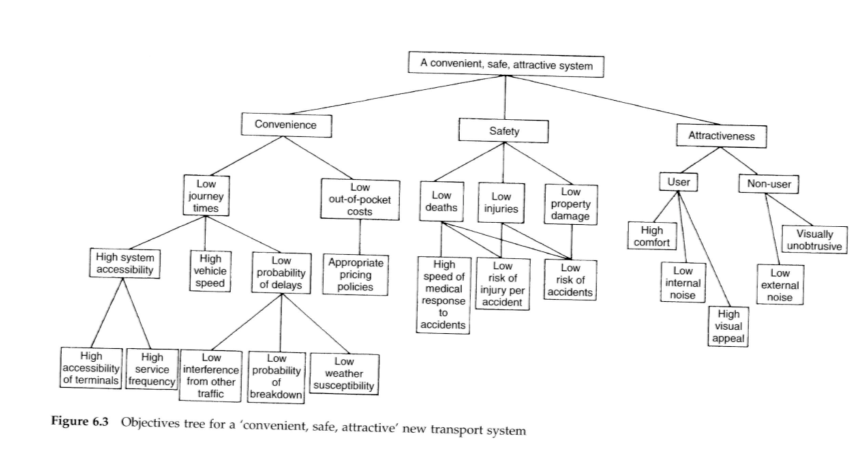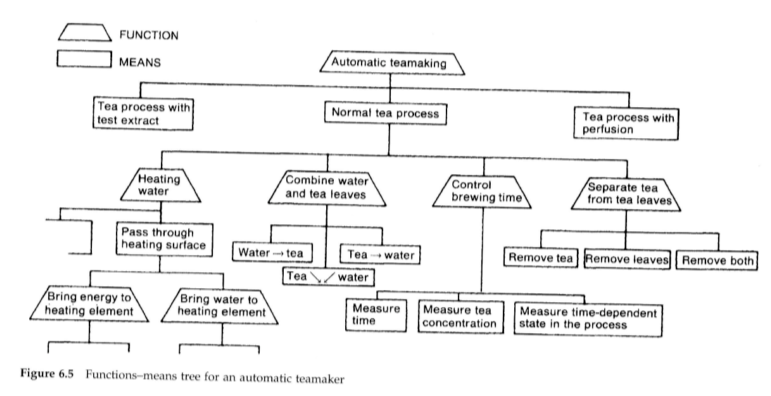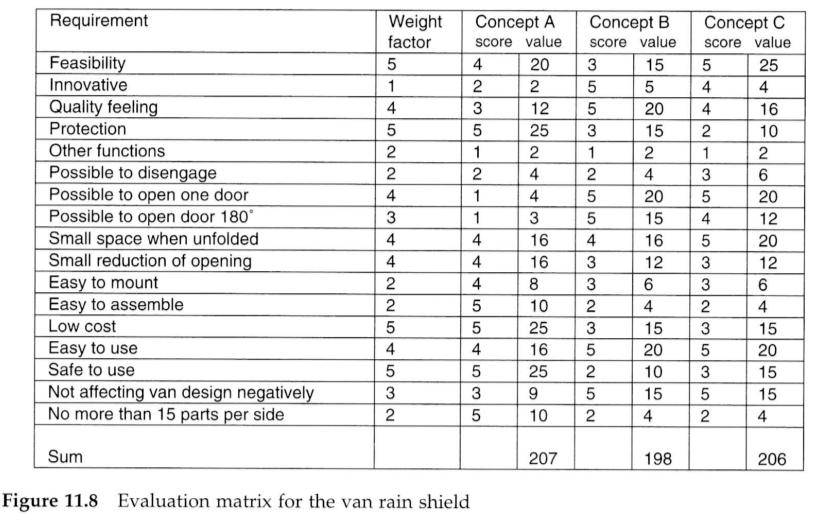Contents
Week 12 – Capstone design: building solutions 1
Date 11/23
- Topic: Capstone design 3
- In-class: Develop the selected solution
- Assignment: Project progress report on online portfolio
Pre-Class
Rapid Prototyping Methods by Google. (updated at 3:52 pm 11/23/2020)
Discussion:
- What prototyping methods presented in the video?
- Why the Google engineer prefer paper prototypes to a digital form at the initial stage of designing?
In-Class
Evaluating Alternatives
When a range of design ideas has been created, you will need to have a next important step which is selecting alternatives. In your project document, you may have various alternatives solutions or features. For selecting alternative, engineers sometimes use ‘intuition’ by experience, gut, arbitrary decision. However, it is better if a choice can be made by rational, logical, and reasonably sound manners.
When evaluating alternatives, you should begin with your design goal by considering the objectives that the design is supposed to achieve. The evaluation assesses the overall ‘value’ and ‘utility’ of a particular design idea with the respect to the design problems and objectives (Cross, 2008)
Before you start selecting alternatives, you will need to clarify
- What is your design goal?
- What are your design criteria (requirements)?
- What are the design constraints (limitation)?
Weighted Objectives Method
This method provides a means of assessing and comparing alternative designs using weighted objectives. It assigns numerical weights to design requirements and numerical scores to the anticipated or tested performances of the alternative design ideas.
Warning: In this process, you will give a score for each design idea but the numerical operation cannot be applied to the quality of the design solution. For example, when you gave score ‘3’ to idea A and ‘9’ to idea B. This cannot be interpreted that idea B is three times better than idea A.
Procedure
- List the design objectives:
- Review your design criteria (requirements), constraints, and other measures.
- In stating your design objectives, include multiple aspects such as safety, economics, user and other related factors.
- At first, we will focus on quantitative assessment, so your objectives should be written in this manner.
- Rank-order the list of objectives:
- Some of objects may be considered to be more important than others.
- Use the Pair-wise comparisons

- Example sheet: https://docs.google.com/spreadsheets/d/13ZJQHJFQQQXJYTnMnjtGaeLoheh6Y5dIjmU0yQBYxoY/edit?usp=sharing
- Assign relative weightings to the objectives
- Establish performance parameters or utility scores for each of the objectives
- Determine how to give the weighted scores to each objectives.
- Develop a scale.
- Example for Objective E
- Poor – 1
- Fair – 2
- Moderate – 3
- Good – 4
- Very good – 5
- Example for B
- Far below average – 1
- Below average – 2
- Average – 3
- Above average – 4
- Far above average – 5
- Example for C
- Inadequate – 1
- Weak – 2
- Satisfactory – 3
- Good – 4
- Excellent – 5
- You can consider the evaluation in terms of both quantitative and qualitative
- Calculate and compare the relative utility values of the alternative designs
- Multiply each parameter score by its weighted value.
- The best alternative has the highest sum value
- Do not determine the best solution sorely by the scores.
- Your group will need to discuss based on the scores rather than simply choosing the ‘best’
Examples
Alternative methods & examples
Object Tree Method
Provide a clear and useful format for such a statement of objectives.
- Prepare a list of design objectives.
- Order the list into sets of higher-level and lower-level objectives.
- Draw a diagrammatic tree of objectives.


Evaluating Alternatives with Objective Tree Method
- Each triangle has an objective (top), true value (bottom left), and relative value (bottom right)
- In each layer, the sum of the true values is 1.0.
- A relative value can be obtained by multiplying the true value and the parent’s relative value. e.g.,) O111’s relative value is 0.5 x 0.67 = 0.335 ~= 0.34
- In a branch, the sum of relative values is the parent’s relative value

- Final relative weights can be obtained from the terminal relative weights.
- example
Mock-up Design
- How to realize your design solution? How to test your solution?
- What tools and building materials do you need?
- What computerized tools can we use?
- What strategies does help rapid-prototyping?
Rapid prototyping
Materials strategies for engineering design.
IDEO Method Card
IDEO Method Cards are a tool to showcase methods we use to inspire great design and keep people at the center of our design process. Each of the 51 cards describes one method and includes a brief story about how and when to use it. The card examples will be provided in the class.

Post-Class
-
Assignments
- Idea Exploration (100 pts)
- Describes multiple aspects of design based on your ideations and research outcomes.
- Considers multiple metrics that align with each criterion and constraints and justifies selection of the most valid metrics.
- On the template, Ideations, Design Strategy, Division of tasks among team members (if needed), time line showing dependencies and major testable milestone.
- Due 11/25 (Wednesday)
- No Submission Required. Instructor will access your shared group document.
- Idea Exploration (100 pts)
-
Next step
- Design Prototype (100 pts)
- Addresses the problems identified at the problem identification stage.
- Considers realistic constraints and issues.
- Effectively work to help vulnerable people.
- Due 12/7 (Monday)





 This site is licensed under a Creative Commons Attribution-NonCommercial 4.0 International License. You are free to share (copy and redistribute the material in any medium or format) and adapt (remix, transform, and build upon the material for any non-commercial purpose). Under the following terms you must give appropriate credit, provide a link to the license, and indicate if changes were made.
This site is licensed under a Creative Commons Attribution-NonCommercial 4.0 International License. You are free to share (copy and redistribute the material in any medium or format) and adapt (remix, transform, and build upon the material for any non-commercial purpose). Under the following terms you must give appropriate credit, provide a link to the license, and indicate if changes were made.


Recent Comments